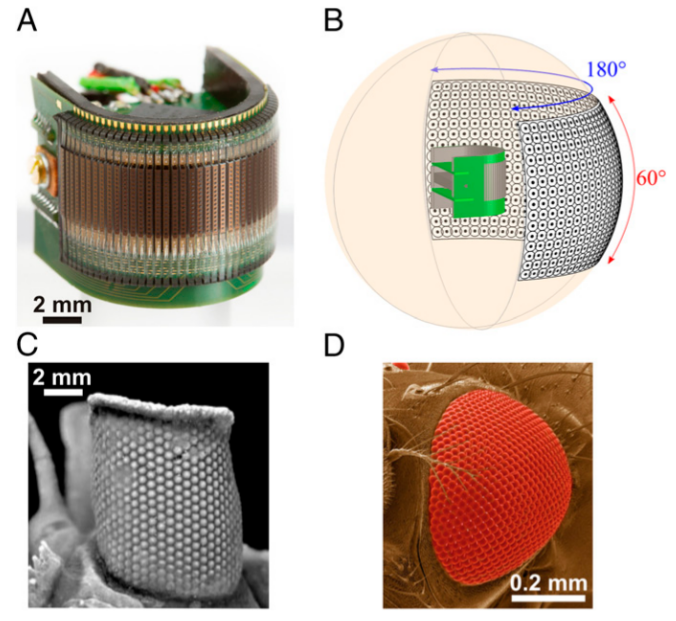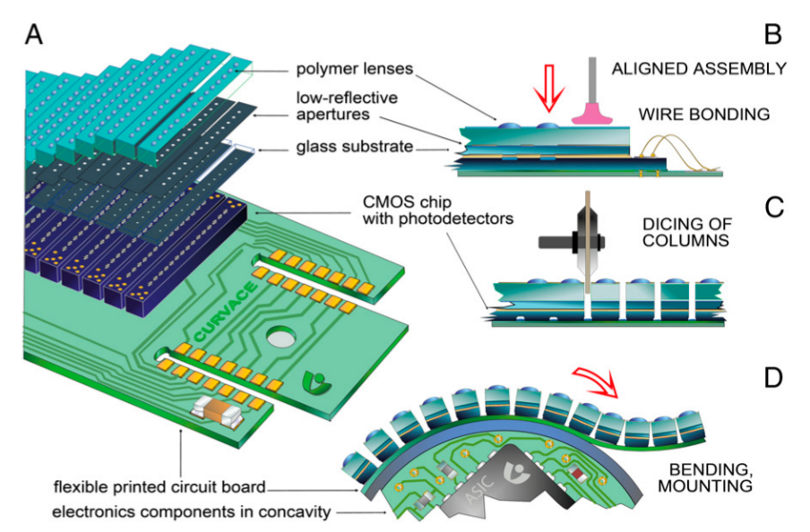Swiss scientists have developed an artificial eye
The faceted eyes , consisting of a number of narrow light-sensitive cones, called ommatidia, are characteristic of insects and crustaceans. Although they have lower resolution than vertebrate eyes, they have a number of advantages - they are less inertial (some insects are able to perceive flickers with a frequency of up to 300 Hz), do not require focusing, and can distinguish not only color, but also the direction of light polarization. A team of scientists from the Federal Polytechnic School of Lausanne (EPFL) has created a prototype artificial eye, which takes advantage of this design.

The artificial eye, which the scientists called CurvACE (CURVed Artificial Compound Eyes), consists of 630 "ommatidia", each of which is a light-sensitive element and a microlens, which focuses on a narrow beam of light. The eye has a viewing angle of 60 degrees in the vertical and 180 degrees in the horizontal plane. Vertically, the angles of view of different ommatidia are given by the shape of microlenses, and horizontally, by the bend of the substrate on which the eye is located. This form is dictated by the manufacturing technology - photosensitive elements are formed on a solid crystal, which is then cut into narrow strips.

')
The eye has a volume of only 2.2 cubic centimeters and weighs 1.75 grams. In industrial production, the current level of technology will reduce its size at least twice. The main purpose of the eye is a visual navigation system for robots. The eye has a high sensitivity and dynamic range - each ommatidium can individually adapt to the level of illumination. Such an eye cannot be blinded by a sun flare. In combination with high speed (the prototype can produce up to 1500 frames per second), small size, no distortion at the edges of the field of view and the ability to relatively easily achieve a circular or even spherical view, this makes it an ideal tool for determining the position of the robot in space, detecting obstacles and collision avoidance.
According to its characteristics, CurvACE approximately corresponds to the eye of the fruit fly Drosophila. Although this is not the first attempt to create an artificial faceted eye, the development of Swiss scientists is distinguished by thoroughness - their goal is to create a comprehensive solution for navigation, and not just an optical sensor. As well as the insect's eye, which contains a nerve node inside, which performs primary image processing, urvACE includes a microcontroller that processes the signal from the sensors using optical flow algorithms, as well as an accelerometer and gyroscope. On the project website you can download libraries for working with the eye.
The electronic filling proper makes up the bulk of the mass and volume of the eye - the array of CMOS sensors with microlenses itself is 1 mm thick and weighs 0.36 grams. The ability to impart any shape to the facet chamber and the absence of large lenses open up many possibilities: such “eyes” can be embedded in the walls of rooms, in clothes or furniture for use in smart home systems or video surveillance. By combining different types of ommatidia in one sensor, you can create a camera that will see at the same time in different ranges.
CurvACE has been developed since 2009. The total project budget is 2.73 million euros. An article with a detailed description of the project is available at this link .

The artificial eye, which the scientists called CurvACE (CURVed Artificial Compound Eyes), consists of 630 "ommatidia", each of which is a light-sensitive element and a microlens, which focuses on a narrow beam of light. The eye has a viewing angle of 60 degrees in the vertical and 180 degrees in the horizontal plane. Vertically, the angles of view of different ommatidia are given by the shape of microlenses, and horizontally, by the bend of the substrate on which the eye is located. This form is dictated by the manufacturing technology - photosensitive elements are formed on a solid crystal, which is then cut into narrow strips.

')
The eye has a volume of only 2.2 cubic centimeters and weighs 1.75 grams. In industrial production, the current level of technology will reduce its size at least twice. The main purpose of the eye is a visual navigation system for robots. The eye has a high sensitivity and dynamic range - each ommatidium can individually adapt to the level of illumination. Such an eye cannot be blinded by a sun flare. In combination with high speed (the prototype can produce up to 1500 frames per second), small size, no distortion at the edges of the field of view and the ability to relatively easily achieve a circular or even spherical view, this makes it an ideal tool for determining the position of the robot in space, detecting obstacles and collision avoidance.
According to its characteristics, CurvACE approximately corresponds to the eye of the fruit fly Drosophila. Although this is not the first attempt to create an artificial faceted eye, the development of Swiss scientists is distinguished by thoroughness - their goal is to create a comprehensive solution for navigation, and not just an optical sensor. As well as the insect's eye, which contains a nerve node inside, which performs primary image processing, urvACE includes a microcontroller that processes the signal from the sensors using optical flow algorithms, as well as an accelerometer and gyroscope. On the project website you can download libraries for working with the eye.
The electronic filling proper makes up the bulk of the mass and volume of the eye - the array of CMOS sensors with microlenses itself is 1 mm thick and weighs 0.36 grams. The ability to impart any shape to the facet chamber and the absence of large lenses open up many possibilities: such “eyes” can be embedded in the walls of rooms, in clothes or furniture for use in smart home systems or video surveillance. By combining different types of ommatidia in one sensor, you can create a camera that will see at the same time in different ranges.
CurvACE has been developed since 2009. The total project budget is 2.73 million euros. An article with a detailed description of the project is available at this link .
Source: https://habr.com/ru/post/188620/
All Articles